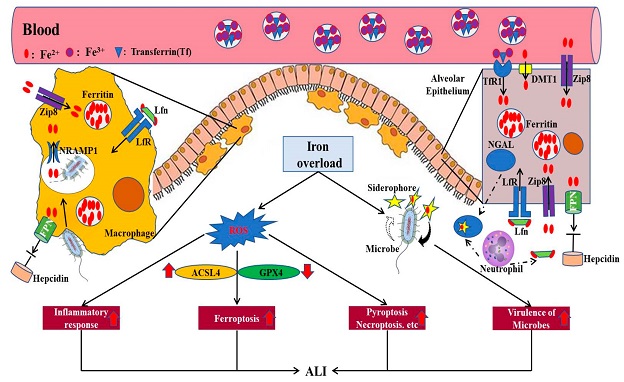Canadian Researchers Identify A Revolutionary Therapeutic Approach For Acute Lung Injury In COVID-19
COVID-19 News: The battle against Acute Lung Injury (ALI) has been a longstanding challenge for healthcare systems worldwide, and with the advent of the COVID-19 pandemic, the urgency to find effective treatments has intensified.
 The detrimental effects of iron overload in the development of ALI. Overloaded iron in the lung, including alveolar epithelium and macrophages, can accelerate the production of ROS, thus inducing the inflammatory response, ferroptosis, pyroptosis, and necroptosis of pulmonary epithelial cells. In addition, excess iron can promote the virulence of microbes aggravating the development of ALI. FPN, ferroportin; NRAMP1, natural resistance–associated macrophage protein 1; ZIP8, zinc transporter SLC39A8; Lfn, lactoferrin; LfR, lactoferrin receptor; DMT1, divalent metal transporter 1; TfR1, transferrin receptor 1; NGAL, neutrophil gelatinase–associated lipocalin; ROS, reactive oxygen species; GPX4, glutathione peroxidase 4; ACSL4, Acyl-CoA synthetase long-chain family.
Acute Lung Injury
The detrimental effects of iron overload in the development of ALI. Overloaded iron in the lung, including alveolar epithelium and macrophages, can accelerate the production of ROS, thus inducing the inflammatory response, ferroptosis, pyroptosis, and necroptosis of pulmonary epithelial cells. In addition, excess iron can promote the virulence of microbes aggravating the development of ALI. FPN, ferroportin; NRAMP1, natural resistance–associated macrophage protein 1; ZIP8, zinc transporter SLC39A8; Lfn, lactoferrin; LfR, lactoferrin receptor; DMT1, divalent metal transporter 1; TfR1, transferrin receptor 1; NGAL, neutrophil gelatinase–associated lipocalin; ROS, reactive oxygen species; GPX4, glutathione peroxidase 4; ACSL4, Acyl-CoA synthetase long-chain family.
Acute Lung Injury or ALI, characterized by compromised pulmonary gas exchange, high morbidity, and mortality rates, lacks well-established preventive and curative measures. However, a promising ray of hope emerges from a new Canadian study conducted by researchers at Dalhousie University. This study reveals that iron dysregulation plays a crucial role in ALI, presenting
iron chelation as a novel and potentially transformative therapeutic approach for the treatment of ALI, especially in the context of COVID-19.
The Role of Iron in Health and Disease
Iron is an essential trace mineral vital for numerous biological functions in virtually all living organisms. It is crucial for DNA synthesis, cellular energy metabolism, enzyme catalysis, and red blood cell production. Iron homeostasis is carefully maintained by mechanisms involving iron absorption from the diet and recycling of senescent red blood cells.
In iron deficiency, cellular functions, including erythropoiesis, are impaired, and anemia may ensue. Conversely, iron overload can lead to oxidative stress, ferroptosis, and damage to healthy cells, causing inflammation and contributing to the pathogenesis of various diseases, including cardiovascular disease and cancer.
Iron Dysregulation in Acute Lung Injury (ALI)
In ALI, both direct and indirect pathogenic insults can trigger lung injury. During the COVID-19 pandemic, ALI emerged as a significant complication of severe acute respiratory syndrome coronavirus 2 (SARS-CoV-2) infection. Iron dysregulation plays a critical role in COVID-19's pathogenesis, leading to increased ferroptosis, oxidative stress, and inflammation as demonstrated in previous studies and
COVID-19 News reports. Hyperferritinemia and hepcidin dysregulation are associated with multiple organ failure in COVID-19 patients, underscoring the importance of iron in the disease's severity.
In direct ALI,
bacteria or viruses can induce iron dysregulation, impacting macrophage ferroportin expression and bacterial virulence. Indirect ALI, on the other hand, is triggered by systemic inflammatory responses, such as those occurring during sepsis or ischemia-reperfusion injury. In both cases, iron plays a crucial role in amplifying cell damage and inflammation.
Iron Chelation as a Therapeutic Strategy
Given the significant role of iron dysregulation in ALI, iron chelation emerges as a promising therapeutic strategy. Iron chelators are compounds that bind to excess iron in the body, preventing it from causing oxidative stress and cellular damage.
Several clinically approved iron chelators, such as deferoxamine (DFO), deferiprone (DFP), and deferasirox (DFX), have been used to manage iron overload conditions like thalassemia.
In Acute Lung Injury (ALI), iron chelators can mitigate the toxic effects of excess iron by reducing its availability and inhibiting ferroptosis. These chelators have demonstrated potential in experimental treatments for ALI, effectively attenuating lung tissue damage and improving microcirculation.
Advancements in Iron Chelation Therapy
Despite the promise of current iron chelators, some limitations hinder their widespread use. For instance, the need for intravenous or subcutaneous administration and short half-lives poses challenges for clinical application. However, newer synthetic iron chelators with improved properties, such as low toxicity profiles and higher binding affinity for iron, show promise in preclinical studies.
Moreover, advances in the design of iron chelators, utilizing polymer nanoparticles to control drug release and improve organ-targeting efficiency, hold immense potential for future developments in this field.
Conclusion
The Canadian study sheds light on the critical role of iron dysregulation in the development and progression of ALI, especially in the context of COVID-19. Iron chelation emerges as a revolutionary therapeutic approach, holding the potential to alleviate the damaging effects of excess iron, mitigate inflammation, and improve patient outcomes.
While current iron chelators show promise, ongoing research is necessary to optimize their properties and enhance their efficacy. By harnessing the power of iron chelation, healthcare systems worldwide may soon have a groundbreaking treatment option to combat ALI, revolutionizing patient care and offering new hope in the battle against severe lung injuries caused by COVID-19 and other pathogenic insults.
The study findings were published in the peer reviewed journal: Life
https://www.mdpi.com/2075-1729/13/8/1659
For the latest
COVID-19 News, keep on logging to
Thailand Medical News.
